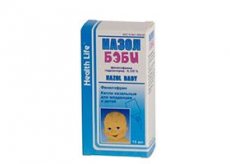Medical expert of the article
New publications
Preparations
Nasol Baby
Last reviewed: 03.07.2025

All iLive content is medically reviewed or fact checked to ensure as much factual accuracy as possible.
We have strict sourcing guidelines and only link to reputable media sites, academic research institutions and, whenever possible, medically peer reviewed studies. Note that the numbers in parentheses ([1], [2], etc.) are clickable links to these studies.
If you feel that any of our content is inaccurate, out-of-date, or otherwise questionable, please select it and press Ctrl + Enter.

External remedy for a runny nose Nazol baby is an α-adrenomimetic drug from a series of decongestants. The active ingredient of the drug is phenylephrine, which according to the ATX classification has the code 1101AA04.
Release form
Nazol baby is available in the form of intranasal drops, 5 ml, 10 ml, 15 ml or 30 ml of 0.125% solution. The bottle is polyethylene, with a screw cap and a built-in spout. The cap has a conical shape with a protective ring, guaranteeing the integrity of the packaged bottle.
Nazol baby drops are a transparent, almost colorless liquid, which contains phenylephrine g/x 0.125 g, as well as additional substances in the form of benzalkonium chloride, glycerol, macrogol, sodium dihydrogen phosphate, etc.
Pharmacodynamics
Phenylephrine hydrochloride is the main active ingredient of Nazol baby. It eliminates swelling and redness of the mucous membranes, reduces exudative discharge, helps to restore freedom of breathing, and lowers pressure in the paranasal sinuses and in the middle ear cavity. These properties are characteristic of this active component, as it is an agonist of α1-adrenergic receptors (sympathomimetic substance). Its main action is vasoconstriction, which occurs by activating α1-receptors in the superficial mucous layer. Due to this, congestion in the tissues weakens, and the patency of the nasal sinus openings improves.
Dosing and administration
Nazol Baby is intended only for instillation into the nasal cavity. To apply the drops, turn the bottle upside down and squeeze it slightly with your fingers.
The dosage of the drug is calculated as follows:
- for children from birth to one year of age – 1 drop, once every 6 or more hours;
- children from one to six years old – 1-2 drops once every six hours;
- children over six years of age and adults – 3-4 drops at a time.
The duration of therapy is no more than 3 days in a row.
Before instillation, it is recommended to clear the nasal passages of mucus and tilt your head back.
Use Nasol Baby during pregnancy
Adequate experimental studies on the use of Nazol baby by pregnant and lactating women have not been conducted. Since the drug is recommended for use in children from the age of six, women during pregnancy should use other medications recommended by a doctor.
Contraindications
- Tendency to allergic reactions to individual components of the drug Nazol baby.
- Pathologies of the heart and blood vessels (in particular, ischemic heart disease or coronary artery sclerosis).
- Persistent high blood pressure.
- Hyperthyroidism.
- Diabetes mellitus.
- Pregnancy and lactation period.
- Children under six years of age.
Side effects Nasol Baby
Side effects during treatment with Nazol baby occur rarely and may manifest as local or systemic reactions:
- itching, pain and discomfort in the nasal cavity;
- headaches, dizziness;
- tachycardia, heart rhythm disturbances;
- increased blood pressure;
- increased sweating;
- paleness of the skin;
- trembling in the fingers;
- sleep disorders.
After finishing treatment with Nazol baby, side effects disappear on their own.
Overdose
There is no specific information about possible overdose of Nazol Baby. Theoretically, one can assume the occurrence of such symptoms as heart rhythm disorders, headache, heaviness in the legs, high blood pressure, irritability.
 [ 21 ]
[ 21 ]
Interactions with other drugs
Shelf life
Attention!
To simplify the perception of information, this instruction for use of the drug "Nasol Baby" translated and presented in a special form on the basis of the official instructions for medical use of the drug. Before use read the annotation that came directly to medicines.
Description provided for informational purposes and is not a guide to self-healing. The need for this drug, the purpose of the treatment regimen, methods and dose of the drug is determined solely by the attending physician. Self-medication is dangerous for your health.

